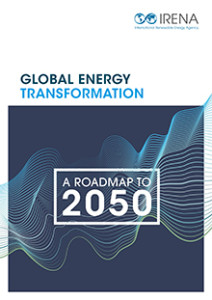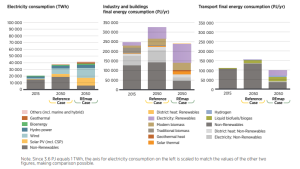 This report points out how to achieve a transition towards renewable energies on both supply and demand side, by outlining necessary technological changes and investment level: bioenergy can be an essential feature to this tranformation.
This report points out how to achieve a transition towards renewable energies on both supply and demand side, by outlining necessary technological changes and investment level: bioenergy can be an essential feature to this tranformation.
To make this transformation come true, investments related to renewable energy, energy efficiency and flexibility along with those associated with power grids need to increase around 30% between 2015 and 2050 (up to USD 120 trillion, around 2% of the average global GDP per year). However, cost-benefit analysis concludes that the benefits of this changeover would totally eclipse the additional costs: an average of USD 6 trillion annually by 2050 vs. 1.7 trillion annually in 2050.
Renewable energy installed capacity has risen in the last decade, yet, there is still a long way to go: Paris Agreement goals about world average temperature are far from being reached and current and planned policies are not sufficient since the world would exhaust its energy-related “carbon budget” in under 20 years to meet such targets.
Two Pillars of The Energy Transition
The keys to completely overturn this process, according to IRENA’s report, are energy efficiency and renewable energy deployment. Current energy mix includes significant use of traditional bioenergy, but, if scaled up significantly, modern bioenergy being sourced from sustainable and affordable feedstocks can be an essential key feature to this energy metamorphosis. A much stronger collective effort, though, is needed in shipping, aviation and other industrial sectors.
Four Key Sectors
Concerning transport sector, electrification of transportation, biofuels, as well as the introduction of green hydrogen would play a vital role in cutting down CO2 emissions for about 70% by 2050. Being second to electricity from renewable energy, liquid biofuels and biogas would represent the consistent share of 22% on total final energy consumption within sector. Entire liquid biofuel production would grow from 129 billion litres in 2015 to over 900 billion litres in 2050: half of this quantity would be represented by advanced biofuels. Electric, biofuels, hybrid and fuel cell vehicles would be used on a large scale.
As far as it concerns for buildings, energy efficiency is critical. Under Remap scenery, renewable shares would rise from the 36% in 2015 to 77% in 2050. Heat pumps would become more common, up to over 250 million units. Traditional and modern biomass would reach 7.6 EJ/yr (exajoule per year). Modern biomass would represent 14% of buildings final energy consumption. Bioenergy in general would meet about 30% of heating and cooking demand, while the use of biogas becomes more significant.

Use of renewable and fossil energy in electricity generation, buildings and industry, and
transport – Reference and REmap cases, 2015-2050 (TWh/yr or PJ/yr)” Source: IRENA RoadMap to 2050
Industry sector is the one needing the most effort since it is responsible for a third of emissions worldwide, due to many energy-intensive and high-temperature processes being applied: in 2015 renewable energy consisted in 7% share of direct energy use, without considering electricity. Largest percentage increase would be in solar thermal heat technologies and heat-pumps for low-temperature processes. For medium and high temperature processes, bioenergy would remain essential: under Remap circumstances, its use would increase the most in absolute terms, and biomass would be the highest contributor to renewable energy share in direct uses within industrial sector.
A decarbonised power sector, dominated by renewable sources, is at the core of the transition: according to IRENA’s Remap case, the share of renewable energy would increase from 25% in 2017 to 85% by 2050, mostly thanks to solar and wind power generation.
Overall benefits
By these means, in 2050 renewables could represent two-thirds of the global energy mix, with some differences between countries which may be overcome by national policies addressed to underlying structural deficits.
This transition would lead to multiple positive effects in terms of environment and socio-economic well-being. By 2050, the Remap scenery would generate a 15% increase in welfare, 1% in GDP (for a total of USD 52 trillion cumulative gain) and 0.1% in employment (19.0 million new jobs against the loss of 7.4 million jobs related to fossil fuels decline). In addition to that, environmental positive results in terms of GHG emissions, air, soil and water quality, as well as energy savings and a better management of resources will be greatly significant.
This post written by Chiara Pappalardo is based on IRENA (2018) “Global Energy Transformation: A Roadmap to 2050, International Renewable Energy Agency”, Abu Dhabi.
To read full report, please click here.


